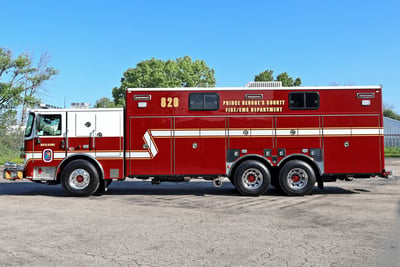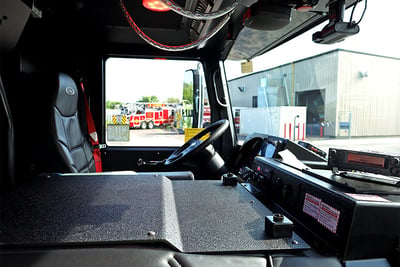 When every second counts, the right apparatus can make all the difference.
When every second counts, the right apparatus can make all the difference.
For Prince George’s County Fire/EMS Department, meeting complex rescue demands means spec’ing a heavy-duty rescue apparatus with intentional design, proven performance and operational consistency.
Explore how the department partnered with Pierce Manufacturing to build a heavy-duty rescue unit to meet their equipment needs, response priorities and long-term fleet strategy.
Prince George’s County Fire/EMS Department
 Prince George's County Fire/EMS Department is one of the busiest fire departments in the region, handling more than 183,000 annual incidents across 45 stations. With an average of 802 responses per day, the department maintains a robust fleet, which includes more than 100 engines, 26 trucks, eight heavy-duty rescue squads and 120 ambulances to serve the diverse emergency needs of the community.
Prince George's County Fire/EMS Department is one of the busiest fire departments in the region, handling more than 183,000 annual incidents across 45 stations. With an average of 802 responses per day, the department maintains a robust fleet, which includes more than 100 engines, 26 trucks, eight heavy-duty rescue squads and 120 ambulances to serve the diverse emergency needs of the community.The department's strategic location, outside Washington, D.C., presents unique operational challenges.
- Prince George's County is intersected by two major thoroughfares featuring high-speed roadways, which contribute significantly to the department's call volume.
- The primary response types include vehicle accidents requiring complex extrications, structure fires and medical emergencies.
- The high-volume operation requires specialized apparatus designed to handle the unique demands of both urban and suburban emergency response scenarios.
The Mission: Rescue Squad No.820
Rescue Squad No.820, operating within this demanding environment, exemplifies the department's commitment to comprehensive emergency services. In 2024 alone, this single unit's coverage area generated more than 1,800 responses, demonstrating the critical need for versatile, reliable apparatus.
The squad's primary mission centers on three core response types:
- Vehicle accidents requiring complex extrication capabilities.
- Medical emergencies where specialized equipment and expertise are critical.
- Structure fires demanding immediate rescue operations.
This operational profile demands a heavy-duty rescue apparatus designed to respond rapidly while carrying a comprehensive array of tools and equipment.
Listen into this insightful podcast from Fire Apparatus & Emergency Equipment diving into Rescue Squad No.820.
Apparatus Overview: Enforcer™ Walk-In Heavy-Duty Rescue
The Rescue Squad No. 820 apparatus is built on a Pierce® Enforcer™ chassis featuring a 2-door cab with a 50-inch extension, creating what is known in the industry as a "true stubby" design.
This configuration prioritizes enhanced maneuverability without sacrificing operational capabilities.
- The shortened wheelbase and overall length of the Enforcer design deliver significant operational benefits, particularly when responding to incidents along the county's major thoroughfares where space constraints and traffic congestion can limit apparatus positioning options.
- The improved turning radius enables the squad to navigate tight access situations effectively, whether maneuvering around accident scenes on busy highways or accessing residential areas with narrow streets and limited turnaround space.

Prince George's County Fire/EMS Department chose a traditional walk-in compartment configuration for Rescue Squad No.820. This traditional rescue squad configuration offers several critical advantages for the unit's operational mission.
- The walk-in compartment provides seating capacity for five firefighters within the rear compartment, bringing the total crew capacity to seven.
- The enclosed walk-in design provides superior equipment protection from dirt, debris and environmental elements, which are particularly problematic during highway responses and extended incident operations.
- A secure storage environment protects sensitive equipment including meters, rope systems and rigging equipment, from moisture and contamination.

“The traditional walk-in compartment design has proven its effectiveness over decades of rescue operations. For our department, protecting critical equipment combined with the ability to carry more crew made it the right choice.”
- Richard Riley, Fire Apparatus Manager
Curious about heavy-duty walk-in rescues? We have more information here.
Key Features Engineered for Heavy Rescue Operations
Rescue Squad No.820 incorporates specialized features designed specifically to meet Prince George County's operational environment.
Extended Front Bumper System
The apparatus features an extended front bumper system engineered to accommodate the department-mandated 15,000-pound winch. The bumper design also includes reinforced corners, which provide enhanced durability during demanding rescue scenarios where the apparatus may encounter challenging positioning requirements or contact with debris.
Integrated storage trays are strategically positioned within the bumper system to house block and tackle equipment, ensuring immediate access to critical rigging components during rescue operations. Additionally, dedicated chain storage compartments provide secure organized storage for heavy-duty chains used in vehicle stabilization and recovery operations.
Vehicle Stabilization Capabilities
The front-mounted winch system serves a dual purpose beyond traditional recovery operations, providing essential vehicle stabilization capabilities during complex extrications. This feature prevents unwanted vehicle movement during rescue operations, ensuring crew safety and operational effectiveness when working around unstable vehicles.
The apparatus is designed to utilize a nose-in approach strategy for accident scenes, allowing crews to position the winch system for maximum stabilization. Comprehensive stabilization tool storage ensures all necessary equipment for vehicle securing and stabilization operations is readily accessible and properly organized.
Advanced Scene Lighting System
Rescue Squad No.820 is equipped with an advanced scene lighting system built around both 12-volt system scene lights and generator-powered lighting capabilities. The 12-volt system provides immediate lighting for initial response operations, while the generator-powered system supports extended operations requiring sustained illumination.
The department's "turn night into day" philosophy drives the lighting system design, ensuring increased safety during fireground operations through superior visibility during nighttime and low-visibility emergency responses.
Standardized Strategy: Reducing Costs and Improving Readiness
 Prince George's County Fire/EMS Department has implemented a comprehensive standardization strategy using Pierce Manufacturing as their apparatus manufacturer. Fleet standardization provides three primary advantages: mechanical consistency, equipment uniformity and cost savings.
Prince George's County Fire/EMS Department has implemented a comprehensive standardization strategy using Pierce Manufacturing as their apparatus manufacturer. Fleet standardization provides three primary advantages: mechanical consistency, equipment uniformity and cost savings.
Mechanical Components
Mechanical component standardization reduces diagnostic and troubleshooting time while enhancing the mechanic’s expertise through repetition with familiar systems. Whether it’s hydraulic systems or simple parts such as headlights, fuel filters and alternators, standardization simplifies maintenance. Mechanics can seamlessly transition between apparatus without needing to re-learn system configurations. This strategic, consistent approach also decreases training requirements across the maintenance team.
Emergency Equipment
Emergency equipment standardization includes:- Consistent hydraulic tools across all apparatus
- Standardized stabilizers and struts
- Common hand tools and equipment
- Mandated equipment placement
This standardized approach eliminates the learning curve associated with different equipment interfaces and ensures crews can locate essential tools immediately, even when operating unfamiliar apparatus. The consistency proves particularly critical during mutual aid operations and personnel transfers between units where rapid equipment familiarity can impact response effectiveness.
Financial and Operational Impact
Standardization enables the department to navigate pricing and best manage ongoing parts procurement. When mechanical issues arise, standardized inventory allows for quick sourcing of replacement parts, minimizing apparatus downtime and maintaining optimal fleet readiness for critical emergency response operations. Standardization helps ensure apparatus up-time.
Interested in learning more? Read out blog: What Are the Benefits of Standardizing A Fire Truck Fleet?
Equipment Layout and Apparatus Design Philosophy
 A well-planned apparatus starts with understanding how equipment shapes the design. Prince George's County Fire/EMS Department works closely with Pierce Manufacturing to leverage engineering expertise to accommodate for specific equipment, weight distribution and balancing firefighter needs with operational requirements.
A well-planned apparatus starts with understanding how equipment shapes the design. Prince George's County Fire/EMS Department works closely with Pierce Manufacturing to leverage engineering expertise to accommodate for specific equipment, weight distribution and balancing firefighter needs with operational requirements.
The department isn’t new to this process. In fact, this apparatus is a sister unit to another rig already in service with a third apparatus on the way. Proven performance and an initial successful deployment with a standardized heavy-duty rescue configuration help guide and reinforce the department’s design decisions for long-term operational consistency.
Listen to our recent Pierce™ Dispatch podcast where we talk with Richard Riley from Prince George County Fire/EMS Department about fire apparatus fleet management.
Key Takeaways for Fire Service Leaders
Successful heavy-duty rescue apparatus procurement begins with thoughtful research and collaborative planning.
“Start by evaluating manufacturers’ capabilities and past projects, then involve both engineers and frontline firefighters early in the specification process. Working with Pierce Manufacturing meant we were able to tailor our apparatus to match equipment needs, safety goals and real-world response demands.”
- Richard Riley, Fire Apparatus Manager
 When it comes to best practices for procurement, an equipment-driven design philosophy works best for Prince George's County Fire/EMS Department. The department benefits from standardizing apparatus across their fleets, promoting consistency and simplifying training.
When it comes to best practices for procurement, an equipment-driven design philosophy works best for Prince George's County Fire/EMS Department. The department benefits from standardizing apparatus across their fleets, promoting consistency and simplifying training.
With the right planning and partnerships, departments can build apparatus designed to perform reliably today and evolve to meet tomorrow’s challenges.
If you're in the early planning stages of procuring a new fire apparatus or are new to a fire truck planning committee, our Fire Truck Purchasing Guide can help! View, download, save and share now to gain in-depth insights and expert advice on every aspect of the procurement process. Let’s work together to build a fire truck designed to serve and protect your community.
Interested in reading other fire departments’ procurement stories? Here are a few more examples: